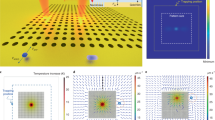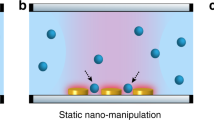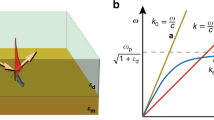Abstract
The ability to control the position of a mesoscopic object with nanometric precision is important for the rapid progress of nanoscience. One of the most promising tools to achieve such control is optical tweezers, which trap objects near the focus of a laser beam. However, the drawbacks of conventional tweezers include a trapping volume that is diffraction-limited and significant brownian motion of trapped nanoobjects. Here, we report the first experimental realization of three-dimensional nanometric optical tweezers that are based on nanostructured substrates. Using electromagnetically coupled pairs of gold nanodots in a standard optical tweezers set-up, we create an array of subwavelength plasmonic optical traps that offer a significant increase in trapping efficiency. The nanodot optical near-fields reduce the trapping volume beyond the diffraction limit and quench brownian motion of the trapped nanoparticles by almost an order of magnitude as compared to conventional tweezers operating under the same trapping conditions. Our tweezers achieve nanoscale control of entities at significantly smaller laser powers and open new avenues for nanomanipulation of fragile biological objects.
This is a preview of subscription content, access via your institution
Access options
Subscribe to this journal
Receive 12 print issues and online access
$209.00 per year
only $17.42 per issue
Buy this article
- Purchase on Springer Link
- Instant access to full article PDF
Prices may be subject to local taxes which are calculated during checkout





Similar content being viewed by others
References
Eigler, D. M. & Schweizer, E. K. Positioning single atoms with a scanning tunnelling microscope. Nature 344, 524–526 (2000).
Bustamante, C., Bryant, Z. & Smith, S. B. Ten years of tension: single-molecule DNA mechanics. Nature 421, 423–427 (2003).
Lewis, A. et al. Near-field optics: From subwavelength illumination to nanometric shadowing. Nature Biotechnol. 21, 1378–1386 (2003).
Ashkin, A., Dziedzic, J. M., Bjorkholm, J. E. & Chu, S. Observation of a single-beam gradient force optical trap for dielectric particles. Opt. Lett. 11, 288–290 (1986).
Grier, D. G. A revolution in optical manipulation. Nature 424, 810–816 (2003).
Crocker, J. C. & Grier, D. G. When like charges attract: The effects of geometrical confinement on long-range colloidal interactions. Phys. Rev. Lett. 77, 1897–1900 (1996).
Wang, G. M., Sevick, E. M., Mittag, E., Searles, D. J. & Evans, D. J. Experimental demonstration of violations of the second law of thermodynamics for small systems and short time scales. Phys. Rev. Lett. 89, 050601 (2002).
Cran-McGreehin, S. J., Dholakia, K. & Krauss T. F. Monolithic integration of microfluidic channels and semiconductor lasers. Opt. Express 14, 7723–7729 (2006).
Molloy, J. E. & Padgett, M. J. Lights, action: optical tweezers. Cont. Phys. 43, 241–258 (2002).
Neuman, K. C. & Block, S. M. Optical trapping. Rev. Sci. Instrum. 75, 2787–2809 (2004).
Dholakia, K. & Reece, P. Optical manipulation takes hold. Nano Today 1, 18–27 (2006).
Abbondanzieri, E. A., Greenleaf, W. J., Shaevitz, J., Landick, W.R. & Block, S. M. Direct observation of base-pair stepping by RNA polymerase. Nature 438, 460–465 (2005).
Born, M. & Wolf, E. Principles of Optics (Cambridge Univ. Press, Cambridge, 1999).
Grigorenko, A. N. et al. Nanofabricated media with negative magnetic permeability at visible frequencies. Nature 438, 335–338 (2005).
Betzig, E. & Trautman, J. K. Near-field optics: microscopy, spectroscopy and surface modification beyond the diffraction limit. Science 257, 189–195 (1992).
Ebbesen, T. W., Lezec, H. J., Ghaemi, H. F., Thio, T. & Wolff, P. A. Extraordinary optical transmission through subwavelength hole arrays. Nature 391, 667–669 (1998).
Fang, N., Lee, H., Sun, C. & Zhang, X. Sub-diffraction-limited optical imaging with a silver superlens. Science 308, 534–537 (2005).
Kawata, S. & Sugiura, T. Movement of micrometer-sized particles in the evanescent field of a laser beam. Opt. Lett. 17, 772–774 (1992).
Novotny, L., Bian, R. X. & Xie, X. S. Theory of nanometric optical tweezers. Phys. Rev. Lett. 79, 645–648 (1997).
Quidant, R., Petrov, D. & Badenes, G. Radiation forces on a Rayleigh dielectric sphere in a patterned optical near field. Opt. Lett. 30, 1009–1011 (2005).
Volpe, G., Quidant, R., Badenes, G. & Petrov, D. Surface plasmon radiation forces. Phys. Rev. Lett. 96,, 238101 (2006).
Reece, P. J., Garcés-Chávez, V. & Dholakia, K. Near-field optical micromanipulation with cavity enhanced evanescent waves. Appl. Phys. Lett. 88, 221116 (2006).
Garcés-Chávez, V. et al. Extended organization of colloidal microparticles by surface plasmon polariton excitation. Phys. Rev. B 73, 085417 (2006).
Gu, M., Haumonte, J.-B., Micheau, Y., Chon, J. W. M. & Gan, X. Laser trapping and manipulation under focused evanescent wave illumination. Appl. Phys. Lett. 84, 4236–4238 (2004).
Grigorenko, A. N. et al. An antisymmetric plasmon resonance in coupled gold nanoparticles as a sensitive tool for detection of local index of refraction. Appl. Phys. Lett. 88, 124103 (2006).
Panina, L. V., Grigorenko, A. N. & Makhnovskiy, D. P. Metal–dielectric medium with conducting nanoelements. Phys. Rev. B 66, 155411 (2002).
Su, K.-H. et al. Interparticle coupling effects on plasmon resonances of nanogold particles. Nano Lett. 3, 1087–1090 (2003).
Rechberger, W. et al. Optical properties of two interacting gold nanoparticles. Opt. Commun. 220, 137–141 (2003).
Wright, A. J., Wood, T. A., Dickinson, M. R., Gleeson, H. F. & Mullin, T. The transverse trapping force of an optical trap: factors affecting its measurement. J. Mod. Opt. 50, 1521–1532 (2003).
Kuiru, L., Stockman, M. I. & Bergman, D. J. Self-similar chain of metal nanospheres as an efficient nanolens. Phys. Rev. Lett. 91, 227402 (2003).
Wright, W. H., Sonek, G. J. & Berns, M. W. Parametric study of the forces on microspheres held by optical tweezers. Appl.Opt. 33, 1735–1748 (1994).
Happell, J. & Brenner, H. Low Reynolds Number Hydrodynamics with Special Applications to Particulate Media (Prentice Hall, Englewood Cliffs, NJ, 1965).
Sidorov, A. R., Zhang, Y., Grigorenko, A. N. & Dickinson, M. R. Nanometric optical tweezers based on nanostructured substrates. Opt. Commun. 278, 439–444 (2007).
Pralle, A., Prummer, M., Florin, E.-L., Stelzer, E. H. K. & Horber, J. K. H. Three-dimensional high resolution particle tracking for optical tweezers by forward scattered light. Microsc. Res. Technique 44, 378–386 (1999).
Acknowledgements
This research was supported by EPSRC (UK) and the Paul Instrument Fund. We thank H. F. Gleeson for kind permission to use the optical tweezers set-up.
Author information
Authors and Affiliations
Corresponding author
Rights and permissions
About this article
Cite this article
Grigorenko, A., Roberts, N., Dickinson, M. et al. Nanometric optical tweezers based on nanostructured substrates. Nature Photon 2, 365–370 (2008). https://doi.org/10.1038/nphoton.2008.78
Received:
Accepted:
Published:
Issue Date:
DOI: https://doi.org/10.1038/nphoton.2008.78
This article is cited by
-
Facile construction of a degradable and renewable superhydrophobic indole-based hemiaminal aerogel for efficient oil–water separation
Journal of Materials Science (2023)
-
Low-temperature optothermal nanotweezers
Nano Research (2023)
-
Light-driven single-cell rotational adhesion frequency assay
eLight (2022)
-
Optically-assisted thermophoretic reversible assembly of colloidal particles and E. coli using graphene oxide microstructures
Scientific Reports (2022)
-
A proposal for optomechanical bichromatic wavelength switching for two-color up-conversion application
Optical and Quantum Electronics (2022)



